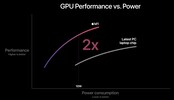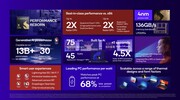Apple M1 7-Core GPU vs Qualcomm SD X Adreno X1-45 1.7 TFLOPS vs Apple M1 Pro 14-Core GPU
Apple M1 7-Core GPU
► remove from comparison
The Apple M1 GPU is an integrated graphics card offering 7 cores (1 deactivated core in the entry MacBook Air) designed by Apple and integrated in the Apple M1 SoC. According to Apple it is faster and more energy efficient as competing products (like the Tiger Lake Xe GPU). The peak performance of the high end variant with 8 cores is 2.6 teraflops, therefore the 7 core version should offer around 2.3 teraflops. Thanks to the unified memory architecture it should have fast access to the RAM.
The Apple M1 is manufactured in the modern 5nm process at TSMC and should offer an excellent energy efficiency.
Qualcomm SD X Adreno X1-45 1.7 TFLOPS
► remove from comparison
The 1.7 TFLOPS Adreno X1-45 is an integrated graphics adapter that the Snapdragon X Plus 8-core X1P-42-100 SoC features. Compared to the faster 3.8 TFLOPS and 4.6 TFLOPS X1-85 iGPUs, this little guy does not just run at lower clock speeds but also has fewer unified shaders at its disposal, with 768 being the most likely number. The 2.1 TFLOPS X1-45 variant on the other hand only differs in clock speeds.
Architecture
The underlying architecture is reportedly (ChipsAndCheese) in many respects the same as what was used in the Adreno 730, rendering the iGPU DirectX 12-compatible but not DirectX 12 Ultimate-compatible. Ray tracing is only supported via Vulcan 1.3. The highest OpenGL version supported is ES 3.2. The iGPU enjoys access to fast enough RAM but has comparatively small and slow caches to work with. AVC, HEVC and AV1 video codecs can be both hardware-decoded and hardware-encoded; with VP9, only decoding is possible.
The highest monitor resolution supported is UHD 2160p rather than SUHD 4320p.
Performance
A lot depends on the power targets of a specific system, just like it is with AMD, Intel and Nvidia products. That being said, the 1.7 TFLOPS model is on par with the GeForce GTX 950M and significantly behind the Iris Xe Graphics G7 (80 EUs) in synthetic benchmarks. Games put it really close to the GeForce MX350 which is a lot better; still, this kind of performance is only just sufficient for pre-2020 games and resolutions such as HD 720p.
It is also worth mentioning that Qualcomm's graphics drivers aren't quite as polished as what AMD, Intel and especially Nvidia have to offer, leading to severe visual artefacts in certain games. A lot of games won't start at all.
Power consumption
Snapdragon X Plus 8-core chips normally consume no more than 30 W, including the on-package RAM. This makes it highly unlikely that the iGPU will ever get to eat more than 20 W.
Since TSMC's N4P process is employed, it's safe to say power efficiency is going to be better than average with this iGPU, as of late 2024. It's still far behind Apple's M-series chips of course as our in-depth analysis article shows.
Apple M1 Pro 14-Core GPU
► remove from comparison
The Apple M1 Pro 14-Core-GPU is an integrated graphics card by Apple offering 14 of the 16 cores in the M1 Pro Chip. The 1792 ALUs offer a theoretical performance of up to 4.6 Teraflops (16 core variant with 2048 ALUs offers 5.3 Teraflops).
The graphics card has no dedicated graphics memory but can use the fast LPDDR5-6400 unified memory with a 256 bit bus (up to 200 GBit/s).
The GPU clocks between 389 and 1296 MHz and offers no short term boost (389, 486, 648, 778, 972, 1296 MHz steps according to Powermetrics). The GPU is intended to use Apple Metal 2 API and could still be based on the older PowerVR architectures (last used in the Apple A10).
The Apple M1 Pro is manufactured in the modern 5nm process at TSMC and offers an excellent energy efficiency. According to the internal sensors, the GPU uses 15 Watt under full load.
| Apple M1 7-Core GPU | Qualcomm SD X Adreno X1-45 1.7 TFLOPS | Apple M1 Pro 14-Core GPU | |||||||||||||||||||||||||||||||||||||||||||||||||
| Apple M1 Series |
|
|
| ||||||||||||||||||||||||||||||||||||||||||||||||
| Pipelines | 7 - unified | 768 - unified | 14 - unified | ||||||||||||||||||||||||||||||||||||||||||||||||
| Core Speed | 1278 MHz | 1296 MHz | |||||||||||||||||||||||||||||||||||||||||||||||||
| Memory Type | LPDDR4X-4266 | LPDDR5x | LPDDR5-6400 | ||||||||||||||||||||||||||||||||||||||||||||||||
| Shared Memory | no | yes | no | ||||||||||||||||||||||||||||||||||||||||||||||||
| technology | 5 nm | 4 nm | 5 nm | ||||||||||||||||||||||||||||||||||||||||||||||||
| Date of Announcement | 10.11.2020 | 03.09.2024 | 10.11.2020 | ||||||||||||||||||||||||||||||||||||||||||||||||
| Memory Speed | 8448 MHz | ||||||||||||||||||||||||||||||||||||||||||||||||||
| Memory Bus Width | 128 Bit | ||||||||||||||||||||||||||||||||||||||||||||||||||
| API | DirectX 12_1, OpenGL ES 3.2, OpenCL 3.0, Vulkan 1.3 | ||||||||||||||||||||||||||||||||||||||||||||||||||
| Power Consumption | 20 Watt | 15 Watt | |||||||||||||||||||||||||||||||||||||||||||||||||
| Displays | 3 Displays (max.) | ||||||||||||||||||||||||||||||||||||||||||||||||||
| Features | SUHD 2160p60 resolution support, AVC/HEVC/AV1 encoding and decoding | ||||||||||||||||||||||||||||||||||||||||||||||||||
| Theoretical Performance | 4.6 TFLOPS FP32 | ||||||||||||||||||||||||||||||||||||||||||||||||||
| Memory Bandwidth | 200 GB/s |
|
| |||||||||||||||||||||||||||||
Benchmarks
Cinebench R15 OpenGL 64 Bit + Apple M1 7-Core GPU
GFXBench T-Rex HD Offscreen C24Z16 + Apple M1 7-Core GPU
Average Benchmarks Apple M1 7-Core GPU → 100% n=3
Average Benchmarks Qualcomm SD X Adreno X1-45 1.7 TFLOPS → 65% n=3
Average Benchmarks Apple M1 Pro 14-Core GPU → 136% n=3
* Smaller numbers mean a higher performance
1 This benchmark is not used for the average calculation
Game Benchmarks
The following benchmarks stem from our benchmarks of review laptops. The performance depends on the used graphics memory, clock rate, processor, system settings, drivers, and operating systems. So the results don't have to be representative for all laptops with this GPU. For detailed information on the benchmark results, click on the fps number.

Total War Pharaoh
2023
Baldur's Gate 3
2023
F1 22
2022
Hearthstone
2020
Borderlands 3
2019
Far Cry 5
2018
X-Plane 11.11
2018
F1 2017
2017
Civilization 6
2016
Dota 2 Reborn
2015
The Witcher 3
2015
GTA V
2015
Counter-Strike: GO
2012
Batman: Arkham City
2011Average Gaming Apple M1 7-Core GPU → 100%
Average Gaming 30-70 fps → 100%
Average Gaming Qualcomm SD X Adreno X1-45 1.7 TFLOPS → 68%
Average Gaming 30-70 fps → 63%
Average Gaming Apple M1 Pro 14-Core GPU → 185%
Average Gaming 30-70 fps → 191%
| Apple M1 7-Core GPU | Qualcomm SD X Adreno X1-45 1.7 TFLOPS | Apple M1 Pro 14-Core GPU | |||||||||||||||||||
|---|---|---|---|---|---|---|---|---|---|---|---|---|---|---|---|---|---|---|---|---|---|
| low | med. | high | ultra | QHD | 4K | low | med. | high | ultra | QHD | 4K | low | med. | high | ultra | QHD | 4K | ||||
| Total War Pharaoh | 46.1 | ||||||||||||||||||||
| Cyberpunk 2077 2.2 Phantom Liberty | 15 | 11 | 9 | 8 | |||||||||||||||||
| Baldur's Gate 3 | 13 | 11 | 9 | 9 | |||||||||||||||||
| F1 22 | 35 | 36 | 23 | 16 | |||||||||||||||||
| Tiny Tina's Wonderlands | 27.9 | 21.1 | 13.4 | 10.4 | |||||||||||||||||
| Shadow of the Tomb Raider | 65 | 22 | 41 | 16 | 122 | 58 | 53 | 46 | 30 | ||||||||||||
| Strange Brigade | 73 | 30 | 23 | 19 | |||||||||||||||||
| Far Cry 5 | 37 | 21 | 19 | 18 | |||||||||||||||||
| X-Plane 11.11 | 36 | 19 | 25 | ||||||||||||||||||
| Final Fantasy XV Benchmark | 35 | 15 | 12 | ||||||||||||||||||
| Dota 2 Reborn | 81 | 65 | 54 | 47 | |||||||||||||||||
| The Witcher 3 | 67 | 40 | 22 | 11 | |||||||||||||||||
| GTA V | 92 | 86 | 33 | 14 | |||||||||||||||||
| Apple M1 7-Core GPU | Qualcomm SD X Adreno X1-45 1.7 TFLOPS | Apple M1 Pro 14-Core GPU | |||||||||||||||||||
| low | med. | high | ultra | QHD | 4K | low | med. | high | ultra | QHD | 4K | low | med. | high | ultra | QHD | 4K | < 30 fps < 60 fps < 120 fps ≥ 120 fps | 1 | 1 | | | | | < 30 fps < 60 fps < 120 fps ≥ 120 fps | 3 6 4 | 7 3 2 | 9 2 | 8 1 | | | < 30 fps < 60 fps < 120 fps ≥ 120 fps | 1 | 1 | 1 | 1 | 1 | |
For more games that might be playable and a list of all games and graphics cards visit our Gaming List




















